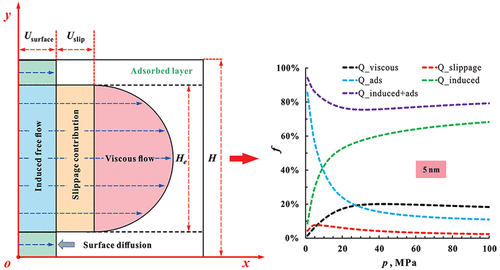当前位置:
X-MOL 学术
›
Energy Fuels
›
论文详情
Our official English website, www.x-mol.net, welcomes your
feedback! (Note: you will need to create a separate account there.)
Shale Gas Transport in Nanopores: Contribution of Different Transport Mechanisms and Influencing Factors
Energy & Fuels ( IF 5.2 ) Pub Date : 2021-01-22 , DOI: 10.1021/acs.energyfuels.0c03463 Xiangyu Liu 1 , Liehui Zhang 1 , Yulong Zhao 1 , Xiao He 2 , Jianfa Wu 3 , Shaowen Su 4
Energy & Fuels ( IF 5.2 ) Pub Date : 2021-01-22 , DOI: 10.1021/acs.energyfuels.0c03463 Xiangyu Liu 1 , Liehui Zhang 1 , Yulong Zhao 1 , Xiao He 2 , Jianfa Wu 3 , Shaowen Su 4
Affiliation

|
The classical Darcy’s law cannot effectively describe the microscopic flow rules of shale gas. In addition, conducting gas transport experiments in nanopores is difficult, and the correctness of the simulation results is not guaranteed. Studies on the flow and transmission of shale gas in microscopic nanopores can effectively guide the macroscopic numerical simulation of shale gas reservoirs, which is of great significance to the economical and efficient development of such reservoirs. In this work, the dimensionless relaxation time expression is modified, and the Peng–Robinson equation of state (P–R EOS) is introduced to the microscale gas flow lattice Boltzmann model. The influences of viscous flow, slippage effect, boundary Knudsen layer, adsorbed gas layer, and surface diffusion are considered, and the results are combined with the real isothermal adsorption experimental data of shale samples collected from the Longmaxi formation in Sichuan Basin. Finally, the contributions of various transport mechanisms to shale gas flow in nanopores and their influencing factors are studied. Results show that the gas velocity and mass flux (Q) obtained using the ideal gas EOS are higher than those obtained using P–R EOS under high pressure. When the effective pore diameter (He) is less than 5 nm, surface diffusion and its induced free flow are the main transport mechanisms of shale gas flow in nanopores. Viscous flow becomes the main transport mechanism when He exceeds 20 nm. He, pressure, and shale adsorption capacity significantly affect the contribution rate of each transport mechanism to the total Q of shale gas. By comparison, the influence of temperature on the Q of shale gas is relatively small and can be neglected under high pressure.
中文翻译:

页岩气在纳米孔中的输运:不同输运机理和影响因素的贡献。
经典的达西定律不能有效地描述页岩气的微观流动规律。另外,在纳米孔中进行气体传输实验是困难的,并且不能保证模拟结果的正确性。研究页岩气在微观纳米孔中的流动和传输,可以有效地指导页岩气储层的宏观数值模拟,这对此类储层的经济高效开发具有重要意义。在这项工作中,修改了无量纲的弛豫时间表达式,并将Peng-Robinson状态方程(P-R EOS)引入了微尺度气流格子Boltzmann模型。考虑了粘性流,滑移效应,边界努森层,吸附气体层和表面扩散的影响,并将结果与四川盆地龙马溪组页岩样品的真实等温吸附实验数据相结合。最后,研究了各种传输机制对页岩气在纳米孔中的流动的影响及其影响因素。结果表明,气体速度和质量通量(使用理想气体EOS所获得的Q)高于使用高压PR EOS所获得的Q)。当有效孔径(H e)小于5 nm时,表面扩散及其诱导的自由流是页岩气在纳米孔中流动的主要传输机制。当H e超过20 nm时,粘性流成为主要的传输机制。H e,压力和页岩吸附能力显着影响每种传输机制对页岩气总Q的贡献率。相比之下,温度对页岩气Q的影响相对较小,在高压下可以忽略不计。
更新日期:2021-02-04
中文翻译:

页岩气在纳米孔中的输运:不同输运机理和影响因素的贡献。
经典的达西定律不能有效地描述页岩气的微观流动规律。另外,在纳米孔中进行气体传输实验是困难的,并且不能保证模拟结果的正确性。研究页岩气在微观纳米孔中的流动和传输,可以有效地指导页岩气储层的宏观数值模拟,这对此类储层的经济高效开发具有重要意义。在这项工作中,修改了无量纲的弛豫时间表达式,并将Peng-Robinson状态方程(P-R EOS)引入了微尺度气流格子Boltzmann模型。考虑了粘性流,滑移效应,边界努森层,吸附气体层和表面扩散的影响,并将结果与四川盆地龙马溪组页岩样品的真实等温吸附实验数据相结合。最后,研究了各种传输机制对页岩气在纳米孔中的流动的影响及其影响因素。结果表明,气体速度和质量通量(使用理想气体EOS所获得的Q)高于使用高压PR EOS所获得的Q)。当有效孔径(H e)小于5 nm时,表面扩散及其诱导的自由流是页岩气在纳米孔中流动的主要传输机制。当H e超过20 nm时,粘性流成为主要的传输机制。H e,压力和页岩吸附能力显着影响每种传输机制对页岩气总Q的贡献率。相比之下,温度对页岩气Q的影响相对较小,在高压下可以忽略不计。











































 京公网安备 11010802027423号
京公网安备 11010802027423号